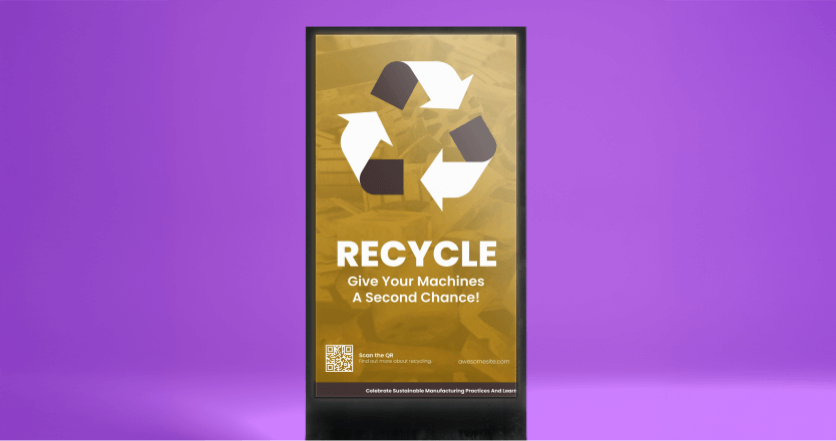Businesses are increasingly recognizing the importance of environmental sustainability, not only to appeal to shareholders, customers, and employees but also as a strategic imperative. In fact, a 2024 survey revealed that 73% of business leaders view eco-conscious initiatives as avenues for revenue growth, with 94% acknowledging their role in enhancing brand value.
While large corporations often have the resources to implement comprehensive green policies, small and medium-sized enterprises are also finding innovative ways to contribute to environmental stewardship. One such approach gaining momentum across businesses of all sizes is the adoption of digital signage. This technology not only modernizes communication but also offers tangible environmental benefits, such as reducing paper waste and lowering carbon emissions.
The shift from traditional to digital signage
Walk into any modern store, airport, or office building, and the chances of seeing a printed poster over a digital screen are getting slimmer by the day. Traditional signage – once the cornerstone of in-store communication – is quietly losing ground. Why? Because it’s static, wasteful, and, frankly, slow. Every new promotion used to mean fresh prints, delivery costs, and installation headaches. Once the campaign ended, all that paper and plastic often ended up in the trash. Multiply that by hundreds of locations, and suddenly you’re talking serious environmental impact – not to mention budget strain.
This is where screens outshine paper (literally!). Digital signage is a cleaner, leaner, faster way to speak to your audience. With a few clicks, brands can update content across hundreds of locations, instantly. No printing. No shipping. No waste. But the shift isn’t just about speed and style. It’s a sustainability win.
How sustainable signage powers modern businesses
Employees want purpose
Today’s workforce, especially Gen Z and millennials, is deeply motivated by purpose. They want to work for companies that share their values and take real action on issues like climate change. According to a Deloitte Global 2023 survey, nearly 40% of Gen Z and millennials have rejected a job or assignment because it didn’t align with their personal values.
By switching to more sustainable technologies like digital signage, companies show they’re not just talking about change; they’re actually making it happen. That message resonates with employees and helps drive recruitment, retention, and loyalty.
A powerful message to customers
Eco-conscious consumers expect brands to reflect their values. Digital signage allows businesses to create high-impact, sustainable customer experiences by replacing paper-heavy promotions with dynamic content that can be updated instantly and waste-free.
Beyond saving resources, it’s a visible statement: “We’re choosing better ways to operate”. That matters to customers. A 2022 IBM report found that more than half of consumers say environmental sustainability is more important to them today than it was a year ago.
A smarter move for shareholders
Once a niche concern, sustainability is nowadays a financial and strategic priority. Shareholders are actively evaluating companies based on ESG (Environmental, social, and governance) performance, and digital signage provides a tangible, measurable way to support those goals.
Eco-friendly digital signage plays a direct role in business outcomes, from cutting material costs to boosting employee retention and fostering customer loyalty. The result is a more resilient organization and a stronger brand.
Tips for eco-friendly digital signage

Seeing how sustainable signage enhances both business outcomes and brand value, you might be wondering how to maximize the eco-friendly potential of digital displays. Here’s how to make digital signage even greener:
1. LED vs. LCD: Choose energy-efficient displays
When it comes to digital signage, LED displays are the clear eco-friendly choice. They use significantly less energy than LCD screens, and their longer lifespan means fewer replacements and less waste. By swapping out traditional LCDs for LEDs, you can cut down on both energy consumption and carbon emissions while still delivering high-quality content.
2. Automate power-off features
One of the simplest ways to reduce your digital signage’s environmental impact is to program it to automatically power off during periods of inactivity, like after business hours. This simple change can drastically reduce energy consumption, especially for large networks of screens. Many modern digital signage systems offer these scheduling features, ensuring your displays are running only when they’re needed.
3. Routine maintenance & support
Just like any technology, digital signage systems need regular maintenance and support to run efficiently over time. Clean, calibrated, and well-maintained displays not only perform better but also consume less energy. Make sure your signage software is up to date and your hardware is in peak condition to avoid unnecessary waste and energy consumption from faulty equipment.
Conclusion
Choosing digital signage over traditional methods makes sense on so many levels. Not only does it boost productivity and employee engagement, but it also contributes to a better customer experience and drives sales. Compared to print marketing, digital signage wins, offering more flexibility, less waste, and lower costs.
While shifting to a more sustainable signage strategy might seem challenging at first, it starts with small, manageable steps. And once you get started, you’ll see that the rewards – financial, environmental, and operational – are well worth the effort.
Ready to promote sustainability through your business?
